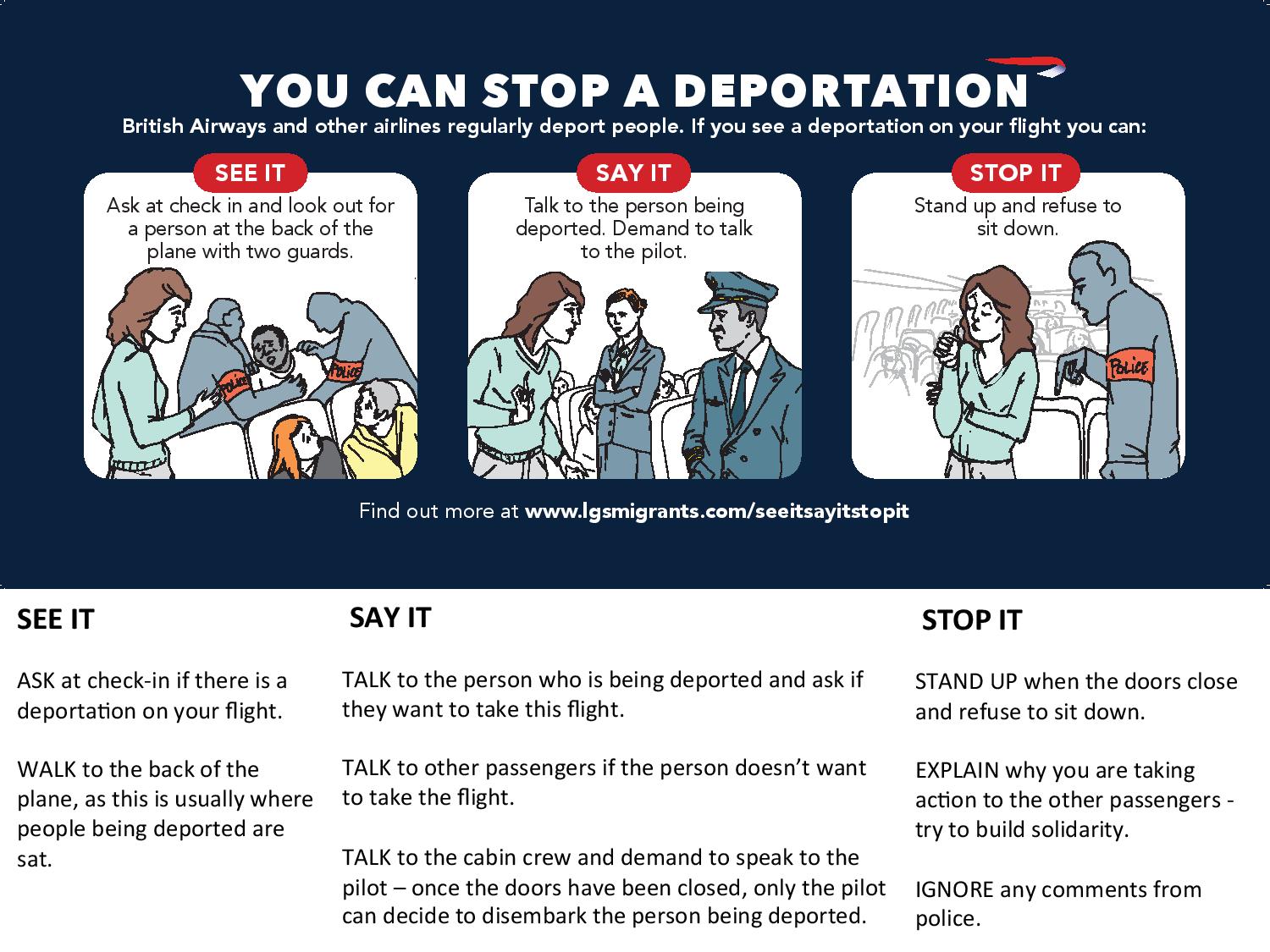SEE IT SAY IT STOP IT
Tens of thousands of people are deported every year from Europe. Some take place in in front of the public on commercial flights. People are not informed in advance of the date and time of their deportation flight. They are treated with violence by their police escort if they try to resist. Some of these people lived in the UK since they were a child. Many have family and children here. Some are deported before their asylum application has been processed.
No one is wilfully deported. Many risk being killed in the country where they are deported to. This is may be why they had left in the first place. Others are being sent to countries in which they have never lived as an adult and have no friends or relatives. The UK regularly deports people to countries the Foreign Office advises travellers not to visit, like Somalia, Afghanistan and Democratic Republic of Congo.
British Airways has been responsible for carrying countless deportees, including LGBTQ asylum seekers and members of the Windrush generation, who were illegally marked for deportation, to countries where they risk persecution, or where they have not set foot for decades. Five years ago, an Angolan passenger, Jimmy Mubenga, died on one such deportation flight carried out by BA.
How to stop a deportation
British Airways and other airlines regularly deport migrants. Deportations are an inhumane and brutal aspect of the hostile environment. People are often sent back to countries where they are at grave risk of harm and persecution.
The guide below is intended to explain how to stop a deportation on your flight. Our way of remembering what steps to take is to ‘See It, Say It, Stop It’.
See It
1. When you arrive at the Departures lounge you can ask at the check-in desk whether anyone is due to be deported on your flight.
2. To identify if someone is being deported on your flight you can also inspect the rear of the plane once you are on board. People being deported are usually flanked by two escorting security guards. They might be in handcuffs or otherwise restrained. They may appear unwell, withdrawn or be visibly distressed.
Say It
1. Once you have reasonable grounds to suspect an individual is being deported go over and talk to that person. Begin with some casual conversation: ask them how they are doing and whether they feel safe. Deportations often involve physical violence as multiple security guards routinely use force to restrain deportees. People subject to deportation are often in pain; they may be struggling with their breathing and/or experiencing high levels of anxiety and fear.
2. Demand to talk to the cabin crew about the situation. Clearly and calmly state that you think the deportation is unjust and that you want the affected person removed from the plane before take off. Explain to them how brutal the hostile environment is, how you are concerned for the person’s safety, or that the Home Office may well be deporting them unlawfully. You can also mention that witnessing a deportation is distressing for a passenger and makes the flight feel unsafe.
3. You can then demand to talk to the pilot. The pilot has the ultimate say in whether the person being deported remains on the flight. (Last year, over 222 flights worldwide were stopped because of the pilot’s concerns that the deportations made those flights unsafe. So the pilot may well be onside!)
Stop It
1. In the event the pilot or senior member of cabin crew do not refuse to fly the person being deported you can stop the deportation yourself. This can be done by standing up on the plane and refusing to sit down when required. The flight cannot take off when you are standing and members of staff cannot physically force you to take your seat.
2. We understand how hard standing up will be. Passengers and crew may well start conversations with you and pressure you to sit down. Passengers may express frustration and anger at you for delaying the flight. Remember that you are saving someone from severe harm, persecution and our unjust immigration system.
3. Tell passengers why you are refusing to allow the flight to take off. This will help you feel more empowered in your stance. Some passengers might even be on your side.
4. Remember that you are not the first person to have stopped a deportation flight. There have been high profile cases such as that of Elin Errson, the Swedish student who refused to sit down on a flight last year, amongst others.
““No one may be removed, expelled or extradited to a State where there is a serious risk that he or she would be subjected to the death penalty, torture or other inhuman or degrading treatment or punishment.” ”



